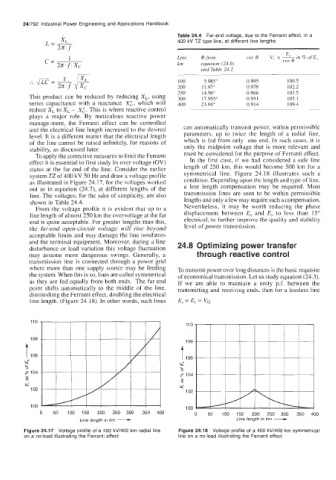Page 838 - Industrial Power Engineering and Applications Handbook
P. 838
24/792 Industrial Power Engineering and Applications Handbook
Table 24.4 Far-end voltage, due to the Ferranti effect, in a
400 kV TZ type line, at different line lengths
E'
9i
in
1 Line 0 from cos 0 v, = - ofE,
Lo) e
C= 2n. f. x, km equutron (24 6)
and Table 24 2
100 5 985" 0 995 100 5
200 11 97" 0 978 102 2
250 14 96" 0 966 103 5
This product can be reduced by reducing XL, using 300 17 955" 0 951 105 1
series capacitance with a reactance X;, which will 400 23 94" 0 914 109 4
reduce X, to X, - X; . This is where reactive control ~
plays a major role. By meticulous reactive power
manage-ment, the Ferranti effect can be controlled
and the electrical line length increaced to the decired can automatically transmit power, within permissible
level. It is a different matter that the electrical length parameters, up to twice the length of a radial line,
of the line cannot be raised infinitely, for reasons of which is fed from only one end. In such cases, it is
stability, as discussed later. only the midpoint voltage that is more relevant and
To apply the corrective measures to limit the Ferranti must be considered for the purpose of Ferranti effect.
effect it is essential to first study its over voltage (OV) In the first case, if we had considered a safe line
status at the far end of the line. Consider the earlier length of 250 km, this would become 500 km for a
system TZ of 400 kV 50 Hz and draw a voltage profile symmetrical line. Figure 24.18 illustrates such a
as illustrated in Figure 24.17, for the voltages worked condition. Depending upon the length and type of line,
out as in equation (24.7), at different lengths of the a line length compensation may be required. Most
line. The voltages, for the sake of simplicity, are also transmission lines are seen to be within permissible
shown in Table 24.4. lengths and only a few may require such a compensation.
From the voltage profile it is evident that up to a Nevertheless, it may be worth reducing the phase
line length of almost 250 km the overvoltage at the far displacement between E, and E, to less than 15"
end is quite acceptable. For greater lengths than this, electrical, to further improve the quality and stability
the far-end open-circuit voltage will rise beyond level of power transmission.
acceptable limits and may damage the line insulators
and the terminal equipment. Moreover, during a line
disturbance or load variation this voltage fluctuation 24.8 Optimizing power transfer
may assume more dangerous swings. Generally, a through reactive control
transmission line is connected through a power grid
where more than one supply source may be feeding To transmit power over long distances is the basic requisite
the system. When this is so, lines are called symmetrical of economical transmission. Let us study equation (24.3).
as they are fed equally from both ends. The far end If we are able to maintain a unity p.f. between the
point shifts automatically to the middle of the line, transmitting and receiving ends, then for a lossless line
diminishing the Ferranti effect, doubling the electrical
line length. (Figure 24.18). In other words, such lines E, = E, = Vo
110
108
t 106
$? 104
Line length in krn -
100
0 50 100 150 200 250 300 350 400 0 50 100 150 200 250 300 350 400
Line length in krn ---+
Figure 24.17 Voltage profile of a 400 kV/400 km radial line Figure 24.18 Voltage profile of a 400 kV/400 km symmetrical
on a no-load illustrating the Ferranti effect line on a no-load illustrating the Ferranti effect

